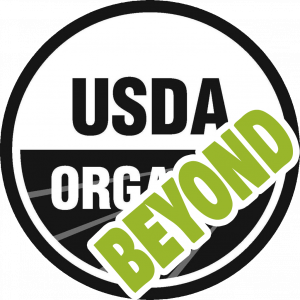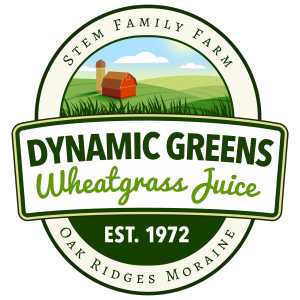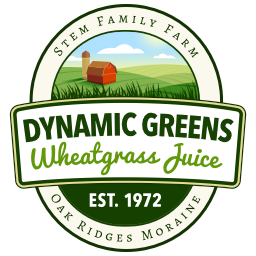 Our wheatgrass juice is (and always has been) far beyond organic. We use only self-sourced non-GMO seed and absolutely no herbicides or pesticides. What most consumers do not realize is that while “organic” is a step in the right direction, the current state is a sub-optimal implementation of this great ideology.
Our wheatgrass juice is (and always has been) far beyond organic. We use only self-sourced non-GMO seed and absolutely no herbicides or pesticides. What most consumers do not realize is that while “organic” is a step in the right direction, the current state is a sub-optimal implementation of this great ideology.
Organic is a restricted marketing term that you must pay to use. We have chosen not to pay to use the word “organic” and therefore are not “certified organic”. That said, understanding what we mean by “beyond organic” is very interesting. It may be too much detail for the average reader but if you choose to forge ahead, you will have knowledge that very few have.
 Chemicals Are Routinely Used In Certified Organic Produce
Chemicals Are Routinely Used In Certified Organic Produce
There are currently 21 chemicals used in organic farming. We use absolutely no herbicides, pesticides or any other chemicals in growing or making our wheatgrass juice. Click to see exactly how we manage weeds and pests.
We Use No Organically Certified Chemicals
At the Stem Family Farm, we grow outdoors naturally, use no chemicals and make the purest and most nutrient dense wheatgrass juice possible. To do so, we embrace ancient farming methodologies, do things the hard (but right) way and stay far away from modern day conveniences of methyl-mercury sprayed seed and the chemicals commonly used in organic farming.
In the case of a caring and conscientious producer of wheatgrass juice, certified organic methodologies do not produce superior food. We will outline the rationale behind this statement and believe you will agree that our approach is beyond organic and produces the best possible wheatgrass juice.

Dr. V.A Tiedjens
We follow the strategies of a brilliant agricultural observer, researcher, teacher and author, Dr. Victor A. Tiedjens. He was a strong proponent of sustainable agriculture and his book from 1965, titled More Food From Soil Science is a masterpiece. He outlines many unique observations and strategies intended to improve the performance of the farm without falling into the traps of short term gains. Most important, the methods have stood the test of time and in fact, many “modern” farmers are returning to these simple roots. We have always incorporated these strategies into our farming and are fortunate to be able to execute them with the benefit of todays robust and better engineered farming equipment.
The Organic Goal – Superior Food
I think it fair to say that every consumer desires the most nutrient dense food possible, no contamination from herbicides / pesticides and growing that is done with a sustainable methodology. In the minds of many consumers, the term “Organic” represents these ideals and in many ways, the organic effort has been a great success by modifying the way in which many of us think and eat.
Where Organic Certification Shines
Of particular importance, organic foods disallow GMO seed sources which are compatible with the broad spectrum herbicide glyphosate. Organic foods limit GMO’s and therefore our intake of glyphosate. This is very important because glyphosate is a chelator that immobilizes something called cations (positively charged ions). The end result is that cation nutrients like calcium, iron, magnesium, potassium and others may be physically present in foods but are not biologically available.
The problem is significant and currently influences feed crops such as corn, soy beans and alfalfa. Through these sources, the glyphosate is being transferred to us. The end result is a peculiar form of malnutrition that has caused the resurgence of 40 plant diseases and serious fertility issues in animal populations. In theory and likely in practice, we are also seriously affected although the evidence supported this is still building.
Please note that we use heirloom seed varieties which are self-sourced and non-GMO.
Where Organic Certification Disappoints
Organic Chemical Use
Many are surprised to hear that a variety of organically certified herbicides and pesticides are sprayed on organic produce. Here is a link to the organic pesticide area of the U.S. Environmental Protection Agency. Of more concern, there have been reports that these chemicals are only marginally effective and as a result, they are applied more frequently and at many times the intensity of traditional chemicals.
DynamicGreens does not use any traditional or organically certified herbicides or pesticides.
Land Management
One of the desirable goals within the organic movement is that the farm self sustains. This means that on an organic farm, nothing is to come from outside the perimeter of the farm unless a known deficiency exists. This creates an interesting paradox because the farm by its very nature is an exporter of nutrition. In the world of hydroponics, this limit is meaningless as the entire environment is deficient; therefore, organic certification makes it permissible to add anything to the fluids that feed the plant. In a field grown culture, this limit makes organic certification undesirable as the land cannot be proactively managed by adding minerals until the soil has been stripped to deficiency and demonstrated as such.
We do not allow our land to become stripped of minerals and this proactive land management actually makes us ineligible for organic certification.
Field vs. Greenhouse Growing
Field growing and greenhouse growing are considered equal in the world of organics. The challenge is that these growing environments are not equal. In the show “The Nature Of Things” episode “Smarty Plants”, David Suzuki showcases a variety of situations in which plants actually exhibit animal behaviours. Specifically, they respond to their environments in many more ways than the simple act of a flower turning toward the sun. The responses often result in the plant releasing phytonutrients into its tissues. These phytonutrients are what form the character of the plant and affect colour, taste, texture and nutrition. In the controlled environment of the greenhouse, the plant doesn’t experience the variability of the natural environment and therefore the plant does not feature the same phytonutrient levels.
We only field grow our plants resulting in the highest possible phytonutrients levels in the plant.
Seed Regulations
Organic food must accept the use of government standards and this can be limiting. As an example, for many years, the wheat marketing board controlled access to wheat berries (seed). The board required that wheat berries held in storage be treated with the fungicide methyl mercury. Therefore, the organic standard was required to embrace the use of methyl mercury treated seed as compliant with organic standards. Beware copper colored wheat berries as they are methyl-mercury treated.
We do not purchase seed treated with methyl mercury fungicide; instead, we thoroughly and rigorously dry our seed so that we do not require fungicide treatment.
Processing Regulations
In the U.S., the law requires that all juice products resold in stores be treated with a process that ensures a 5-log reduction in pathogens. A 5-log reduction is 99.999% effectiveness and it is simply impossible to guarantee this level of destruction without degrading the product. There are only 3 ways to accomplish this goal and they include pasteurization, pascalization or irradiation. Because processing is government requirement for juices resold at a retail store, processing does not affect organic eligibility.
Our juice is sold directly from the farm and we fall under different regulatory criteria. Our juice is undamaged, unpasteurized, unprocessed, raw, living and biologically active.
What We Do
 Our wheatgrass juice is not certified organic, it is far beyond organic because we give you the most nutrition, the least contaminants and what we believe is the best model of sustainable agriculture by:
Our wheatgrass juice is not certified organic, it is far beyond organic because we give you the most nutrition, the least contaminants and what we believe is the best model of sustainable agriculture by:
- Growing without the use of any herbicides or pesticides
- Managing our land to ensure it does not become stripped of vital elements
- Growing outdoors for optimal phytonutrient levels
- Using only self-sourced seed which are free of methyl-mercury
- Keeping our juice unprocessed (unpasteurized) to retain its vitality
In contrast, it is possible to produce an organically certified wheatgrass product that is grown with methyl-mercury coated seeds, raised hydroponically for inferior nutrition, sprayed with organically certified herbicides/pesticides and processed with pasteurization, irradiation or pascalization.
There is no formal alternative to the organic process but we dream of a world of full disclosure where foods list government required exceptions, contain a biological activity reading, indicate indoor or outdoor growing modalities, specify organic herbicide / pesticide / fungicide use and clearly show the effects of food safety processing.
Our family buys organic food, it is a good thing but you just need to realize that it is a marketing stamp, not a quality stamp. By knowing your local farmer, you can get food that is far beyond organic.
